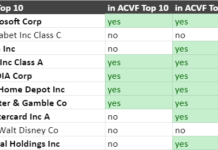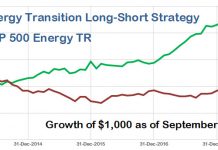Tom Konrad CFA
For many, the decision to get out of fossil fuels is an easy one. It may be because it’s the right thing to do, or because we see the risks of investing in businesses built around an unsustainable economic paradigm. This article is not about that decision; it’s about what to do next.
The Green Portfolio: What And Why
To a lesser extent, it also depends on what we mean when we say “green.” For simplicity, this article will focus on making your portfolio Fossil Fuel Free (FFF), meaning that the portfolio should contain no companies involved in the extraction, refining, or power generation from coal, oil, natural gas, and (usually) nuclear power.
Many investment professionals with the strongest green credentials consider FFF investing less than ideal. Rafael Coven, Managing Director of The Cleantech Group, states that investing in the efficient use of fossil fuels is usually the most cost-effective way to reduce our reliance on them. Yet the FFF movement is not just about the most effective way to reduce fossil fuel use. It also seeks to send a message that our reliance on fossil fuels and their influence on our political system is unacceptable.
Whatever a green portfolio means to you, make sure that the person implementing your strategy understands. Jan Schalkwijk, CFA, a portfolio manager at JPS Global Investments in Portland, Oregon, says that if your advisor tries to talk you out of your chosen strategy, it is time to find a new advisor. One frequent argument is that it will increase risk or lower returns. Schalkwijk cites research demonstrating this need not be true.
The Green Portfolio: How
There are three ways to implement a green portfolio: Selecting individual stocks, selecting mutual funds or ETFs, or paying an advisor to select them for you. Financial resources enable us to pay for advice, while time helps us find good advice or make good investment decisions on our own.
Your financial resource is your whole portfolio, not just the portion currently invested in fossil fuels. Mutual fund and advisor fees are based on the size of your account, and determine how much advice you can buy.
Investing Efficiently
Taking energy use as a metaphor, buying stocks and bonds is like buying wind turbines and solar panels, except in investing, we pay taxes on our gains instead of receiving subsidies. As with energy use, it’s almost always best to reduce our expenditure (costs) before we increase production (invest.)
The easiest way to reduce expenditure is pay down debt such as mortgage, car loans, and credit cards. Upgrading our homes for efficiency and (sometimes) solar can also help. There are few better investments for taxable savings (as opposed to retirement accounts like IRAs.)
Allocation
Building a portfolio starts with asset allocation. An advisor will do this for you, or you can use an online asset allocation calculator like this one to find out how you should allocate you money between stocks, fixed income, and cash.
Funds
There are many green mutual funds available, but few are completely fossil free; I focus on the latter simply to save space. Exchange traded funds (ETFs) are usually a cheaper option, but broad-based fossil free ETFs are not yet available.
According to Garvin Jabusch, Founder and Chief Investment Officer of Green Alpha Advisors in Boulder Colorado, the only truly fossil free broad-based mutual funds he has been aware of are Shelton Green Alpha (NEXTX) and Portfolio 21 (PORTX). Recently, PAX World and Green Century have begun dropping fossil fuel holdings from some of their funds as well. Most other green funds claiming to be fossil free simply avoid the 200 largest fossil fuel companies. This leaves thousands of smaller companies equally committed to fossil fuels. NRDC and Blackrock recently announced new global equity indexes which will exclude fossil fuel companies, but we do not yet have details.
Unfortunately, few of these supply any allocation to fixed income. The exception is the Green Century Balanced Fund (GCBLX), which provides a 19% allocation to fixed income. The PAX World High Yield Bond (PAXHX) is a higher yielding but riskier fixed income option. Schalkwijk says a fossil free fixed income allocation could be met with a number of yield-focused equities (see below.)
Advisors
Many advisors will help you create a green portfolio, but most will do so using mutual funds. If they do, you will pay two layers of fees: One to the advisor, and one to the funds. The double layer of fees may be hidden with commission-based advisors who are paid by the funds, but it’s still there. If you’re willing to do the work, you will probably be better off creating your own mutual fund portfolio as I describe above. I know of three green investment advisors who create portfolios of individual securities for clients, avoiding this double layer of fees. Of these, only Tom Moser of High Impact Investments in Tuscon normally takes clients with less than $50,000 to invest. The others are Schalkwijk’s JPS Global Investments and Jabusch’s Green Alpha Advisors.
The level of customization these advisors are willing to offer depends on how much you are willing to invest, but if you and your advisor are in tune as to what you mean by “green,” they may not consider it customization at all. When choosing advisors, it is also important to understand what your costs will be (both in terms of the advisor’s fees and the costs of the investments they select), and the services they provide. Each of the three above has a unique perspective on green. If any one is not right for you, he will likely help you find someone who is.
Stocks
For those with the time, inclination, and aptitude, a stock portfolio may be the lowest cost option. An often overlooked but very useful resource is the holdings of the fossil free mutual funds mentioned above. Other resources include my own writings and subscription services such as the Roen Financial Report.
On the income side of the picture, the Roen Report has just published a free report on green dividend investing. I am managing a fossil free equity income strategy with the income increased and risk reduced by option selling with Green Alpha Advisors. We’re currently only able to offer it in separate accounts of at least $100,000, but I frequently write about many of the holdings.
|
Your best investment options |
How much you have to invest |
||
|
Time you can spend |
Less than $50,000 |
$50,000 to $100,000 |
Over $100,000 |
|
As little as possible |
Funds |
Funds |
Advisor |
|
A good chunk now, not much ongoing |
Funds |
Advisor |
Advisor |
|
A lot; I like thinking about this |
Stocks |
Advisor, Stocks |
Advisor, Stocks |
Summary
The easiest way to build a green portfolio is to work with an advisor who understands your goals and invests directly in green securities. A number of green mutual funds are also available to the small investor, but more risk-averse investors who need income have fewer options. Real world energy efficiency investments and paying down debt are the best green income investments.
DISCLOSURE: I receive compensation from both JPS Global Investments and Green Alpha Advisors for stock research and portfolio management services.
DISCLAIMER: Past performance is not a guarantee or a reliable indicator of future results. This article contains the current opinions of the author and such opinions are subject to change without notice. This article has been distributed for informational purposes only. Forecasts, estimates, and certain information contained herein should not be considered as investment advice or a recommendation of any particular security, strategy or investment product. Information contained herein has been obtained from sources believed to be reliable, but not guaranteed.








